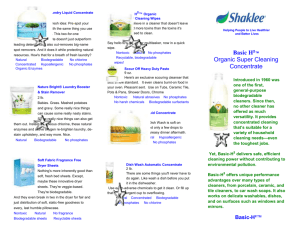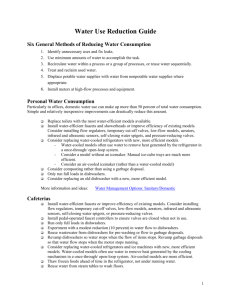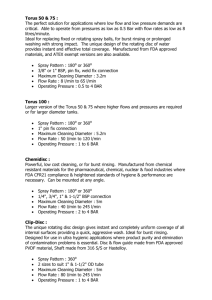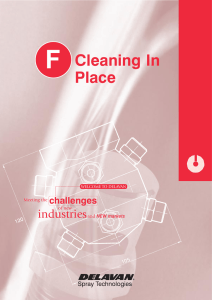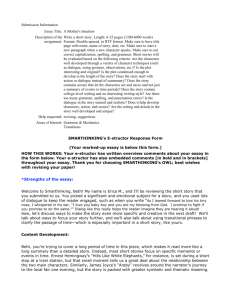SAFETY OPERATING PROCEDURE
advertisement
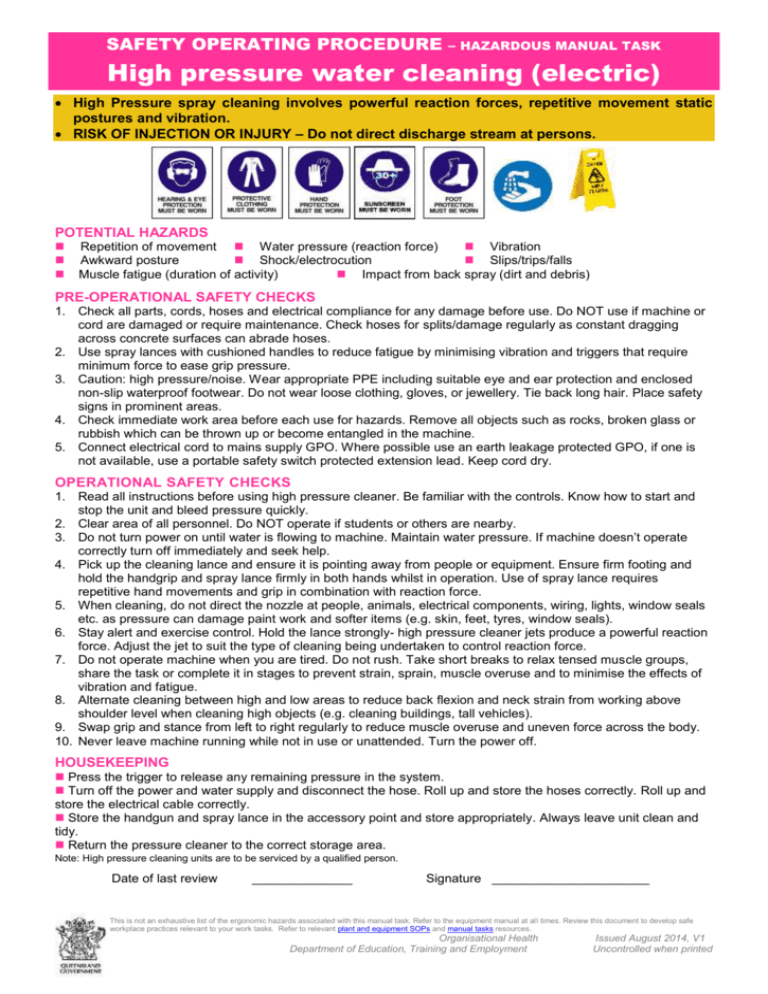
SAFETY OPERATING PROCEDURE – HAZARDOUS MANUAL TASK High pressure water cleaning (electric) High Pressure spray cleaning involves powerful reaction forces, repetitive movement static postures and vibration. RISK OF INJECTION OR INJURY – Do not direct discharge stream at persons. POTENTIAL HAZARDS Repetition of movement Water pressure (reaction force) Vibration Awkward posture Shock/electrocution Slips/trips/falls Muscle fatigue (duration of activity) Impact from back spray (dirt and debris) PRE-OPERATIONAL SAFETY CHECKS 1. Check all parts, cords, hoses and electrical compliance for any damage before use. Do NOT use if machine or cord are damaged or require maintenance. Check hoses for splits/damage regularly as constant dragging across concrete surfaces can abrade hoses. 2. Use spray lances with cushioned handles to reduce fatigue by minimising vibration and triggers that require minimum force to ease grip pressure. 3. Caution: high pressure/noise. Wear appropriate PPE including suitable eye and ear protection and enclosed non-slip waterproof footwear. Do not wear loose clothing, gloves, or jewellery. Tie back long hair. Place safety signs in prominent areas. 4. Check immediate work area before each use for hazards. Remove all objects such as rocks, broken glass or rubbish which can be thrown up or become entangled in the machine. 5. Connect electrical cord to mains supply GPO. Where possible use an earth leakage protected GPO, if one is not available, use a portable safety switch protected extension lead. Keep cord dry. OPERATIONAL SAFETY CHECKS 1. Read all instructions before using high pressure cleaner. Be familiar with the controls. Know how to start and stop the unit and bleed pressure quickly. 2. Clear area of all personnel. Do NOT operate if students or others are nearby. 3. Do not turn power on until water is flowing to machine. Maintain water pressure. If machine doesn’t operate correctly turn off immediately and seek help. 4. Pick up the cleaning lance and ensure it is pointing away from people or equipment. Ensure firm footing and hold the handgrip and spray lance firmly in both hands whilst in operation. Use of spray lance requires repetitive hand movements and grip in combination with reaction force. 5. When cleaning, do not direct the nozzle at people, animals, electrical components, wiring, lights, window seals etc. as pressure can damage paint work and softer items (e.g. skin, feet, tyres, window seals). 6. Stay alert and exercise control. Hold the lance strongly- high pressure cleaner jets produce a powerful reaction force. Adjust the jet to suit the type of cleaning being undertaken to control reaction force. 7. Do not operate machine when you are tired. Do not rush. Take short breaks to relax tensed muscle groups, share the task or complete it in stages to prevent strain, sprain, muscle overuse and to minimise the effects of vibration and fatigue. 8. Alternate cleaning between high and low areas to reduce back flexion and neck strain from working above shoulder level when cleaning high objects (e.g. cleaning buildings, tall vehicles). 9. Swap grip and stance from left to right regularly to reduce muscle overuse and uneven force across the body. 10. Never leave machine running while not in use or unattended. Turn the power off. HOUSEKEEPING Press the trigger to release any remaining pressure in the system. Turn off the power and water supply and disconnect the hose. Roll up and store the hoses correctly. Roll up and store the electrical cable correctly. Store the handgun and spray lance in the accessory point and store appropriately. Always leave unit clean and tidy. Return the pressure cleaner to the correct storage area. Note: High pressure cleaning units are to be serviced by a qualified person. Date of last review ______________ Signature ______________________ This is not an exhaustive list of the ergonomic hazards associated with this manual task. Refer to the equipment manual at all times. Review this document to develop safe workplace practices relevant to your work tasks. Refer to relevant plant and equipment SOPs and manual tasks resources. Organisational Health Department of Education, Training and Employment Issued August 2014, V1 Uncontrolled when printed







